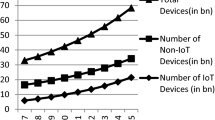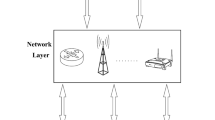Abstract
Physical layer security has gained an increasing attention due to its efficiency and simplicity as compared to other conventional security protocols. Thus, it has been recently nominated for Internet of Things (IoT) applications. In this paper, a novel key distribution mechanism is proposed for IoT networks. The proposed mechanism exploits the channel diversity to distribute encryption keys among nodes within the network. A main novelty aspect of the proposed mechanism is that it guarantees distributing different keys with different lengths to all nodes at the same time. In addition, an intelligent eavesdropper model has been considered. Simulation results prove the high performance of the proposed scheme and its robustness against channel estimation errors, and immunity against eavesdroppers.





Similar content being viewed by others
Change history
28 March 2019
The original version of this article unfortunately contained mistakes in the author group and affiliation sections.
References
Atzori L, Iera A, Morabito G (2010) The internet of things: a survey. Comput Netw 54.15:2787–2805
Luong NC, Hoang DT, Wang P, Niyato D, Kim DI, Han Z (2016) Data collection and wireless communication in internet of things (IoT) using economic analysis and pricing models: a survey. IEEE Commun Surv Tutorials 18(4):2546–2590
Wortmann F, Flüchter K (2015) Internet of things. Business Inf Syst Eng 57.3:221–224
Granjal J, Monteiro E, Silva JS (2015) Security for the internet of things: a survey of existing protocols and open research issues. IEEE Commun Surv Tutorials 17(3):1294–1312
Mukherjee A (2015) Physical-layer security in the internet of things: sensing and communication confidentiality under resource constraints. Proc IEEE 103.10:1747–1761
Shiu YS, Chang SY, Wu HC, Huang SCH, Chen HH (2011) Physical layer security in wireless networks: a tutorial. IEEE Wireless Commun 18(2):66–74
Khisti A, Wornell GW (2010) Secure transmission with multiple antennas: the MIMOME channel. IEEE Trans Inform Theory 56(11):5515–5532
Liang Y, Poor HV (2008) Multiple-access channels with confidential messages. IEEE Trans Inform Theory 54(3):976–1002
Husain MI et al (2012) CD-PHY: physical layer security in wireless networks through constellation diversity. In: Proceedings IEEE MILCOM, pp 1–9
Althunibat S et al (2017) A physical-layer security scheme by phase-based adaptive modulation. IEEE Trans Veh Technol 66(11):9931–9942
Hou W, Wang X, Chouinard JY, Refaey A (2014) Physical Layer Authentication for Mobile Systems with Time-Varying Carrier Frequency Offsets. IEEE Trans Commun 62(5):1658– 1667
Xiao L et al (2007) Fingerprints in the ether: Using the physical layer for wireless authentication. IEEE ICC, Glasgow, 4646– 4651
Althunibat S et al (2018) Physical-layer entity authentication scheme for mobile MIMO systems. IET Commun 12.6:712–718
Sayeed A, Perrig A (2008) Secure wireless communications: secret keys through multipath. IEEE ICASSP
Hassan AA, Stark WE, Hershey JE, Chennakeshu S (1996) Cryptographic key agreement for mobile radio. Digital Signal Process 207-212:6
Azimi-sadjadi B et al (2007) Robust key generation from signal envelopes in wireless networks. In: Proceedings of the 14th ACM conference on computer and communications security. ACM
Premnath SN, Jana S, Croft J, Gowda PL, Clark M, Kasera SK et al (2013) Secret key extraction from wireless signal strength in real environments. IEEE Trans Mob Comput 12(5):917–930. https://doi.org/10.1109/TMC.2012.63
Zan B, Gruteser M, Hu F (2012) Improving robustness of key extraction from wireless channels with differential techniques. IEEE ICNC, 980–984
Wang T, Liu Y, Vasilakos AV (2015) Survey on channel reciprocity based key establishment techniques for wireless systems. Wireless Netw 21.6:1835–1846
Mathur S, Miller R, Varshavsky A, Trappe W, Mandayam N (2011) Proximate: proximity-based secure pairing using ambient wireless signals. In: Proceedings of ACM Mobisys, New York, NY, USA
E.Shehadeh Y, Alfandi O, Hogrefe D (2012) On improving the robustness of physical-layer key extraction mechanisms against delay and mobility. IEEE IWCMC, 1028–1033
Wang Q et al (2011) Fast and scalable secret key generation exploiting channel phase randomness in wireless networks. In: Proceedings of IEEE INFOCOM, pp 1422–1430
El Hajj Shehadeh Y, Hogrefe D (2011) An optimal guardintervals based mechanism for key generation from multipath wireless channels. In: Proceedings of IFIP NTMS, pp 1–5
Liu Y et al (2012) Exploiting channel diversity in secret key generation from multipath fading randomness. IEEE Trans Inf Forensics Secur 7(5):1484–1497
Zeng K (2015) Physical layer key generation in wireless networks: challenges and opportunities. IEEE Commun Mag 53.6:33–39
Edman M et al (2016) On the security of key extraction from measuring physical quantities. IEEE Trans Inf Forensics Secur 11.8:1796–1806
Zhang J et al (2016) Key generation from wireless channels: a review. IEEE Access 4:614–626
Author information
Authors and Affiliations
Corresponding author
Additional information
Publisher’s Note
Springer Nature remains neutral with regard to jurisdictional claims in published maps and institutional affiliations.
The original version of this article was revised: Author Khalid A. Darabkh’s surname was mispelled as “Darabkeh” and his affiliation should be updated to “Computer Engineering Department, School of Engineering, The University of Jordan”.
Rights and permissions
About this article
Cite this article
Alhasanat, M., Althunibat, S., Darabkh, K.A. et al. A Physical-Layer Key Distribution Mechanism for IoT Networks. Mobile Netw Appl 25, 173–178 (2020). https://doi.org/10.1007/s11036-019-01219-5
Published:
Issue Date:
DOI: https://doi.org/10.1007/s11036-019-01219-5




